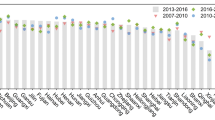Abstract
Russia is one of the largest carbon emitters in the world, possessing huge resources of both fossil fuels and zero-carbon energy sources. The Paris Agreement targets require substantial efforts to limit global warming to “well below 2 °C”. Energy-economic modeling provides sound conclusions that continuation of existing energy and climate policy will lead to stabilization of energy carbon emissions in Russia at the current level in 2010–2050 (about 30% below 1990). Stronger mitigation policies could gradually reduce domestic energy CO2 emissions by 61% from 2010 to 2050 (75% below 1990). Deep decarbonization policies with even more ambitious commitments could ensure an 83% reduction in energy CO2 emissions from 2010 levels (88% below 1990) by 2050. All key sectors (energy, industries, transport, and buildings) can play a substantial role in decarbonizing the national economy. However Russia’s historical reliance on domestic consumption and exports of fossil fuels creates strong barriers to decarbonization. Emission reduction costs are expected to be below 29 USD/tCO2 by 2030, 55 USD/tCO2 by 2040, and 82 USD/tCO2 by 2050 in the most ambitious decarbonization scenario. The results of this study provide insights into how Russia can enhance its ambitions to implement the Paris Agreement and contribute to global efforts toward building a climate-neutral economy by 2050.









Similar content being viewed by others
Notes
Boden, T.A., Marland, G., and Andres, R.J. (2017). National CO2 Emissions from Fossil-Fuel Burning, Cement Manufacture, and Gas Flaring: 1751–2014, Carbon Dioxide Information Analysis Center, Oak Ridge National Laboratory, U.S. Department of Energy, https://doi.org/10.3334/CDIAC/00001_V2017.
Estimates based on data from the International Energy Agency (IEA) and the US Energy Information Administration (EIA).
For example, Japan’s Methane Hydrate R&D Program launched the Research Consortium for Methane Hydrate Resources in Japan (MH21), an industry–government–academia collaboration established to undertake scientific research on technologies for methane hydrate use. The first practical results were reported in 2014, and the technology was to be commercialized in 2017. China also declared a breakthrough in gas-hydrate technology in 2017.
The renewable energy sources in this study exclude large hydropower plants.
The model was developed by a research team from the Russian Presidential Academy of National Economy and Public Administration (RANEPA) with analytical support from the National Research University Higher School of Economics (HSE).
Full documentation of TIMES model is provided in Loulou, R., Remne, U., Kanudia, A., Lehtila, A., Goldstein, G., 2005. Documentation for the TIMES Model - PART I 1–78. https://iea-etsap.org/index.php/etsap-tools/model-generators/times
The model is described in more detail in Potashnikov V., Lugovoy O. (2015) DDPP Analysis Using 15-Sector Input-Output Analysis of the Russian Economy. Institute of Applied Economic Research, Moscow [in Russian]; Lugovoy O., V. Potashnikov, D. Gordeev, Projections of energy balance and greenhouse gas emissions based on RU-TIMES model by 2050, in Scientific Vestnik of Gaidar Institute of Economic Policy, Vol. 5, 2014, pp. 39–43 [in Russian].
For example, the Ministry of Economic Development of Russia (2018) “Economic Development and Innovation Economy” Program; Ministry of Energy of Russia (2017), Energy Strategy of Russian Federation by 2035 (Draft).
Roshydromet (2018), Russian national inventory of greenhouse gases.
IEA, Energy Statistics, https://www.iea.org; WB & IFC (2008), Energy efficiency in Russia: Untapped reserves.
Government of Russian Federation (2018), Concept of long-term socio-economic development of Russian Federation up to 2020.
Bezrukikh P. et al. (2007), The reference book on resources of renewable energy sources in Russia and local types of fuel/ indicators by territories. Moscow, IAC “Energia”, 272 pp. [in Russian]; Costs and benefits of low-carbon transformation in Russia. Perspectives by 2050 and beyond, Ed. I. Bashmakov, Moscow, CENEF, Russia, 2014 [in Russian].
The scenarios in this paper correspond to the CD-LINKS project scenarios for the following national carbon budgets: scenario 1 for 58 GtCO2e, scenario 2 for 45 GtCO2e, and scenario 3 for 40 GtCO2e.
SDSN-IRRDI (2015), DDPP Synthesis 2015 Report, Paris.
Both power and heat production are included in the electricity sector.
Miotti et al. (2016) Personal vehicles evaluated against climate change mitigation targets, Environ. Sci. Technol., 2016, 50 (20), pp. 10795–10804, https://doi.org/10.1021/acs.est.6b00177
References
Bezrukikh P et al (2007) The reference book on resources of renewable energy sources in Russia and local types of fuel/ indicators by territories. Moscow, IAC “Energia”, 272 pp
Boden TA, Marland G, Andres RJ (2017) National CO2 emissions from fossil-fuel burning, cement manufacture, and gas flaring: 1751–2014, Carbon Dioxide Information Analysis Center, Oak Ridge National Laboratory, U.S. Department of Energy, https://doi.org/10.3334/CDIAC/00001_V2017
BP Energy Outlook (2018) edition
IEA (2014) Energy Technology Perspectives 2014
IEA (2015) Energy Technology Perspectives 2015 Mobilising innovation to accelerate climate action. Paris
IEA (2017) World energy outlook 2017. France, Paris
Loulou R, Remne U, Kanudia A, Lehtila A, Goldstein G (2005) Documentation for the TIMES Model - PART I 1–78. https://iea-etsap.org/index.php/etsap-tools/model-generators/times
Ministry of Economic Development of Russia (2018) “Economic development and innovation economy” Program
Miotti et al (2016) Personal Vehicles Evaluated against Climate Change Mitigation Targets. Environ Sci Technol 50(20):10795–10804
OECD (2018) The long view: scenarios for the world economy to 2060
OPEC (2017) World Oil Outlook 2017
Potashnikov V, Lugovoy O (2015) DDPP analysis using 15-sector input-output analysis of the Russian economy. Institute of Applied Economic Research, Moscow
SDSN-IDDRI (2015) Deep Decarbonization Pathways Project. Pathways to deep decarbonization 2015 report - executive summary, Paris
WB & IFC (2008) Energy efficiency in Russia: Untapped Reserves
Acknowledgements
The authors gratefully acknowledge the contributions and comments provided by M. Saparov, H. Waissman, K. Riahi, V. Krey, and many others, including participants of the expert meetings organized by IIASA, HSE, RANEPA and other institutions in 2015–2020. This work is part of a project that has received funding from the European Union’s Horizon 2020 research and innovation program under grant agreement no. 642147 (CD-LINKS).
Author information
Authors and Affiliations
Corresponding author
Additional information
Publisher’s note
Springer Nature remains neutral with regard to jurisdictional claims in published maps and institutional affiliations.
Rights and permissions
About this article
Cite this article
Safonov, G., Potashnikov, V., Lugovoy, O. et al. The low carbon development options for Russia. Climatic Change 162, 1929–1945 (2020). https://doi.org/10.1007/s10584-020-02780-9
Received:
Accepted:
Published:
Issue Date:
DOI: https://doi.org/10.1007/s10584-020-02780-9




